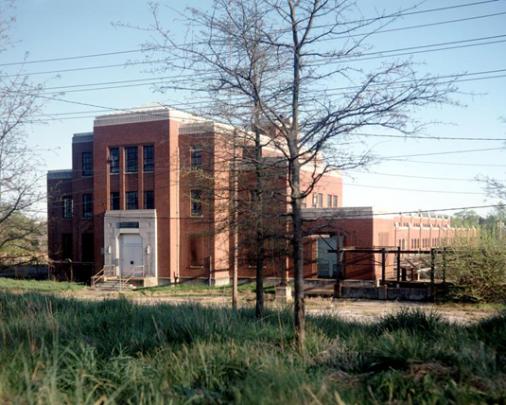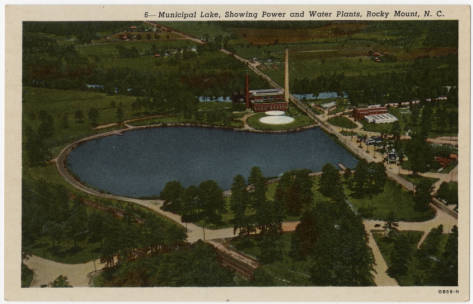Olsen, William C. (1888-1962)
Birthplace:
Mississippi
Residences:
- Kinston, Raleigh NC
Trades:
- Engineer
Building Types:
Styles & Forms:
Spanish Colonial Revival; Modernist; Neoclassical Revival
William C. Olsen (1888-1962), a native of Canton, Mississippi, educated at Cornell University, was a consulting engineer and one of the leading designers of water treatment plants and other facilities in North Carolina during the early 20th century, when urban growth and progressive ideas about sanitation and public services created many opportunities. He frequently worked in association with other architects and engineers, and a number of architects spent portions of their careers in his office. Olsen’s firm continued to gain commissions during the lean years of the Great Depression and worked on military projects during World War II. He planned facilities for Kinston, Fayetteville, High Point, Lexington, and Thomasville, among others. His best known surviving projects are the imposing water plants in Elizabeth City, Rocky Mount, and Raleigh.
According to Olsen’s obituary, after graduating from Cornell he was employed by Westinghouse in Pittsburgh before moving to Durham, N. C., where he worked with engineer Gilbert White. In 1919 he organized his own firm in Kinston, and in 1920 he spent a period in Sumter, S. C. He soon moved to Raleigh, where he spent the rest of his life.
Some of Olsen’s important early work was in Kinston. In 1920 he was identified as an engineer who along with Kinston’s mayor and others sought bids for a power plant and other structures for that city. In 1922 the city of Kinston hired Olsen, already a resident of the town, as consulting engineer to have charge of all work involved in the establishment of the proposed utilities, from drawing the plans of the plants to the laying of the mains. He was to be paid on a commission basis of 4 to 4 ½ percent of the cost of the projects. The Raleigh News and Observer of January 5, 1922 and subsequent carried an advertisement for Olsen as “Consulting Engineer” with offices in Raleigh and Kinston, who offered to take on waterworks, power plants, sewerage, and street improvements.
Later in 1922, while still a resident of Kinston, Olsen was one of six engineers who met with Elizabeth City’s board of aldermen with proposals for “handling the city’s public utilities job,” which was expected to encompass an ensemble of civic electric, water, and sewerage projects to replace old ones (Elizabeth City The Independent, Oct. 24, 1922). The combination of local boosterism and concern for sanitation—major impulses of the 1920s—supported construction of an imposing water treatment plant, which was estimated to cost $250,000 and became a focus of local civic pride.
Designed by Olsen and built by Guion and Company of Gastonia, the Elizabeth City Water Treatment Plant began construction in September, 1926. The local Daily Advance of September 8, 1926 asserted that it would be built in “attractively ornamental fashion,” with the main building to be “of Spanish architecture,” flanked by huge concrete reservoirs and settling tanks, and fronted by a small park. It was estimated that the plant would accommodate not only the city’s existing needs but also growth for “a generation or more.” Another local newspaper, The Independent, reporting on construction progress on April 22, 1927, predicted that the water plant would be “as attractive as a modern school building,” and its surrounding park would make “”down by the water works’. . . a spooning place by night and a playground by day.”
When the facility went into operation later that year, the_ Independent_ estimated that its daily capacity of 2 million gallons could serve “more than twice the present population of the city, producing pure water as safe for human consumption as raindrops (Independent, October 14, 1927)” . The city grew only gradually, from about 8,000 in 1920 to about 19,000 in 2010. Updated over the years, the Elizabeth City plant is one of the few Olsen’s water plants still functioning.
During the Great Depression, Olsen’s firm survived with the aid of public commissions funded in part by the Public Works Administration, such as the Tarboro Water Treatment Plant (1934-1935), the Rocky Mount Waterworks (1935), and the especially imposing E. B. Bain Water Treatment Plant (1940) in Raleigh. Featuring the latest in technology, it was like the Elizabeth City plant an imposing public edifice, but akin to other PWA era edifices it presented a modernist style. “Architecturally Impressive Building Scheduled for Completion in May,” headlined a story in the Raleigh News and Observer of March 31, 1940. “City’s Water Plant Is Engineering Feat,” trumpeted the Raleigh Times of June 18, 1940.
In this period, especially the early years of the Great Depression, some architects whose businesses had dwindled or failed took employment with Olsen’s firm, which had enough work to provide jobs. One of these was Allen J. Maxwell, Jr., who had worked with H. A. Underwood as an employee and partner, but in 1934 joined Olsen’s firm as a draftsman before moving to Goldsboro and founding his own practice in 1935. to Goldsboro and set up his own practice. Architect Charles A. Pearson, a native of Asheville, spent his early years in a Raleigh partnership with Thomas M. Ashe (Pearson and Ashe), then worked on his own for several years, but from 1934 to 1948, he worked for Olsen’s firm, supervising the construction of water and sewage treatment projects across the state.
During the wartime hiatus in civilian construction, Olsen like other engineers and architects took on military contracts, including a facility at Cherry Point Marine Air Station in collaboration with architects William H. Deitrick of Raleigh, George Watts Carr of Durham, and others. Olsen also worked with Deitrick on other wartime projects, producing work valued in the millions of dollars.
After World War II, Olsen collaborated with architect H. Raymond Weeks in planning one of the first major buildings at the Raleigh-Durham Airport. Plans dated 1954 for the airport “administrative building” show that it contained waiting rooms, baggage rooms, restrooms, etc., indicating that it served as the passenger terminal as well as administrative offices; these plans are in the Harris and Pyne Records at NC State University Libraries Special Collections. (An earlier article in the High Point Enterprise of June 18, 1952 had cited George Watts Carr and Olsen as architects and engineers of a proposed passenger terminal at the Raleigh-Durham airport, but evidently the project was reassigned to Olsen and Weeks.
William C. Olsen was married in 1916 to Elsie Marsh (1894-1995) of Belhaven in Beaufort County, and the couple had three children and numerous grandchildren. The Olsens lived for many years in a handsome stone residence at 1806 Glenn Avenue in Raleigh’s Hayes Barton suburb. At his death in 1962, Olsen’s obituary noted that he was an Episcopalian and an “aviation enthusiast,” a Rotarian, and a member of the Chamber of Commerce and the Sphinx Club. He was survived by his wife, two daughters (Mary Marsh Clarkson of Corsicana, Texas, and Martha Ann Sigmon of Raleigh) plus four sisters, sons-in-law, and nine grandchildren (Corsicana Daily Sun, April 9, 1962). Elsie Olsen continued to live in Raleigh, where she was active in civic, church, and social life, until she was more than one hundred years of age. Like her husband, she was buried in Raleigh’s Oakwood Cemetery.
Catherine W. Bishir and Michael T. Southern, A Guide to the Historic Architecture of Eastern North Carolina (1996).
Catherine W. Bishir and Michael T. Southern, A Guide to the Historic Architecture of Piedmont North Carolina (2003).
E. B. Bain Water Treatment Plant
Contributors:William C. Olsen, engineerDates:1939-1940
Location:Raleigh, Wake CountyStreet Address:1810 Fayetteville St.
Status:Standing
Type:Public
Note:The E. B. Bain Water Treatment Plant is part of a larger civic water treatment facility that includes elements from the 1880s and 1920s, but the dominant feature is the water treatment plant of 1939-1940. Olsen had been involved in planning a 1923 expansion of the old water treatment plant, but with Raleigh’s growth in the 1920s and 1930s, it became inadequate. A large new plant was authorized by the city, with the Public Works Administration providing substantial funding and plans and specifications drawn up by Olsen. Incorporating the latest technology in water treatment, the plant was the city’s sole source of treated water from 1940 to 1967. In contrast to Elizabeth City, Raleigh experienced rapid growth in the post-World War II era. New water plants were required in the 1960s and later, and the Bain plant was taken out of service in 1987. Long unused, it has been the focus of various preservation efforts. The main building is a massive 3-story masonry edifice, with a concrete frame clad in Flemish bond brickwork and cast stone trim in a restrained modernist style. Some of the vast interior spaces are treated as formally as civic buildings of the time.
Elizabeth City Water Plant
Contributors:William C. Olsen, engineer; J. N. Pease, engineerDates:1926, 1978
Location:Elizabeth City, Pasquotank CountyStreet Address:N end of Wilson St.
Status:Standing
Type:Public
Images Published In:Catherine W. Bishir and Michael T. Southern, A Guide to the Historic Architecture of Eastern North Carolina (1996)
Note:Built in a landscaped, parklike setting in “attractively ornamental fashion,” the main building was of “Spanish architecture, flanked by huge concrete reservoirs and settling tanks.” In a typical format, the main building is symmetrical in form with a central office pavilion and architect windows lighting the flanking pump and filter rooms. The 1978 annex by J. N. Pease matches the original building. The facility is still in use.
Raleigh-Durham Airport Administrative Building
Contributors:William C. Olsen, engineer; H. Raymond Weeks, architectDates:1954-1955
Location:Wake CountyStreet Address:Wake County, NC
Status:Altered
Type:Commercial
Note:The plans dated 1954 show that the “Administrative Building” contained all the elements of a passenger terminal as well as offices. Whether any elements of that building survive in the extensively altered terminal is unknown; it is slated for demolition.
Rocky Mount Waterworks
Contributors:William C. Olsen, engineerDates:1935
Location:Rocky Mount, Nash CountyStreet Address:NE corner Sunset Ave. and River Dr.
Status:Standing
Type:Public
Images Published In:Catherine W. Bishir and Michael T. Southern, A Guide to the Historic Architecture of Eastern North Carolina (1996)
Note:Like others of Olsen’s 1930s water treatment plants, the facility in Rocky Mount was a project of the Federal Emergency Administration of Public Works. It displays the blend of Art Deco and stripped classicism seen in many such projects. The complex includes an imposing brick office building, a pumping facility, and concrete tanks.
Tarboro Water Treatment Plant
Contributors:William C. Olsen, engineerDates:1934-1935
Location:Tarboro, Edgecombe CountyStreet Address:600 Albemarle Ave.
Status:Standing
Type:Public
Note:In contrast to the more modernist designs of some of Olsen’s water treatment facilities, the Tarboro plant displays a strongly classical character, with a central entrance and office pavilion with quoins and a Palladian type entrance, flanked by wings with arched windows with keystones, which light the functional spaces within. Located within the central part of town, it blends with the predominantly traditional local architecture. Additional elements are of concrete.



